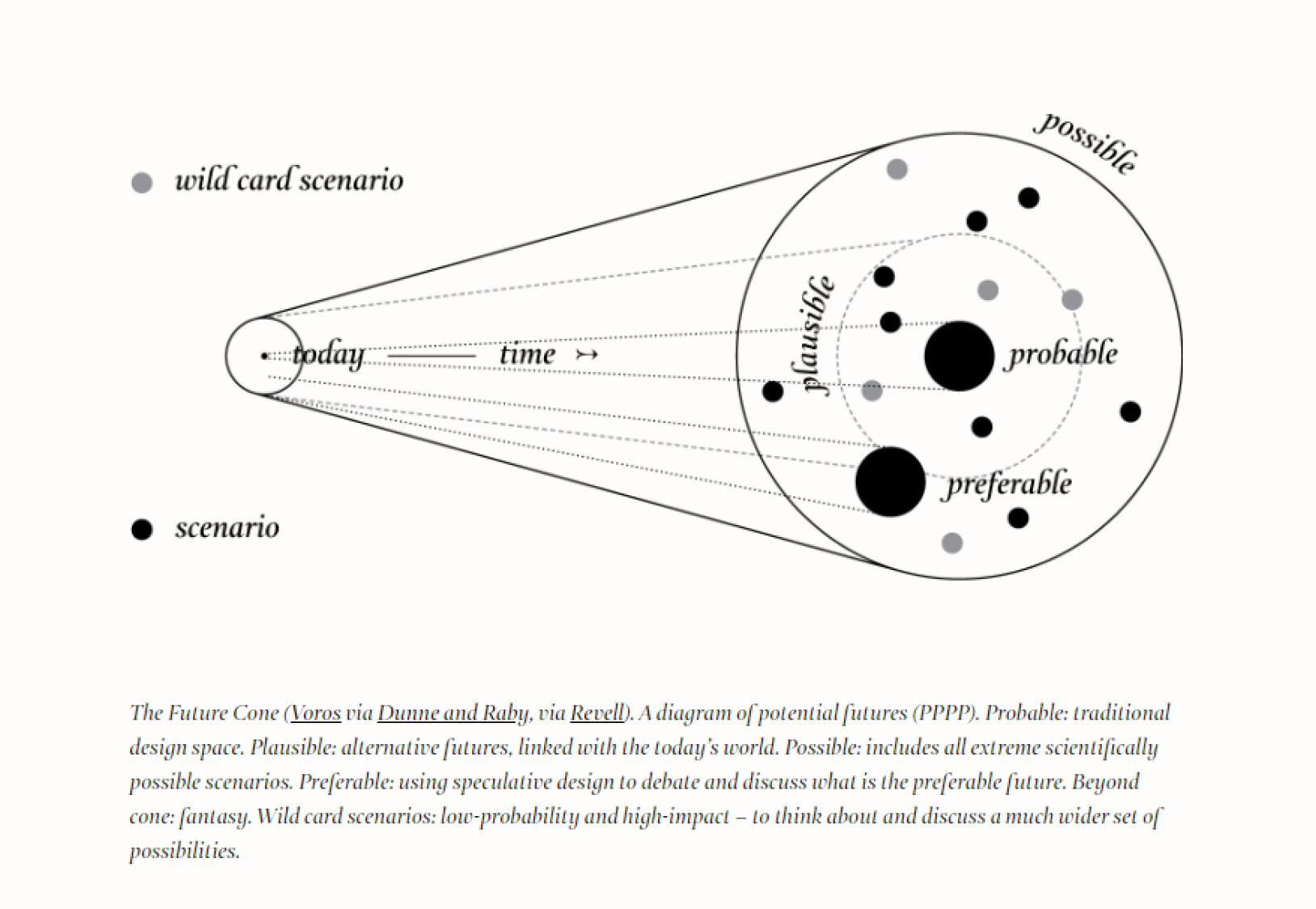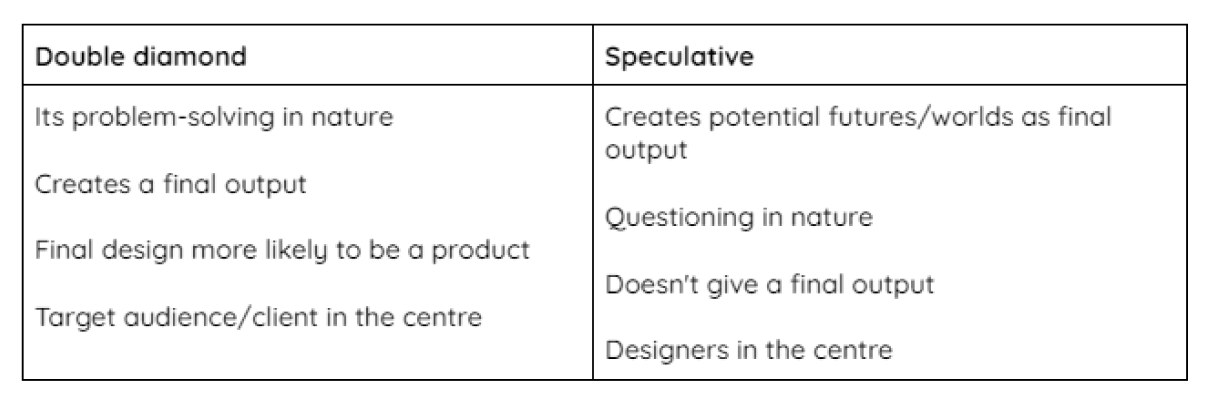Design approach 1: Speculative design
Speculative design
Speculative design is a design framework that works on creating new potential future worlds for us by creating questions and branching out.
It allows the designers to think about worlds and create ‘what if?’ scenarios of the possible future. This framework is more based on the designer and their own creativity, what they think could be a potential future, making the speculative design very flexible with design as it can be as creative as the designer thinks.
Because of this nature of design thinking, this type of design allows us to explore as many potential futures, including both dystopias and utopias. This means it allows us to visually see new technology in the potential future and to think and question how these new technologies would be good for us. This also could help prevent a potential future we don’t want or allow us to help work towards a future we want.

So far, the only other design framework I’ve looked into in the Design programme currently is the double diamond.
The framework begins by ideating, which asks some questions and branches out, and then it iterates back into a final solution to the problem.
The double diamond is a framework that does ask questions; however, the final outcome is a solution to a problem, making it a more problem-solving and critical type of design thinking as it analysis the question to then create an answer.
This is different to the affirmative type of design or speculative design. As speculative design asks questions, and the final outcome is more of a question to get designers and others thinking about the potential futures.
Speculative design also places the designers in the centre, instead of the client/target audience, which the double diamond does.
The speculative design allows designers to be as creative as they want, to focus on what they think and create environments and worlds rather than final products.

Beyond Speculative Design
Strengths
Some strengths that Speculative design has it how it allows for many possibilities, both good and bad futures. It also allows us to think more about the future and, if the potential future isn't desired, how we could change and not go down that path with what we create. This creates questions and changes in our current and could also change mindsets if we were to question and think about a potential future and how we wouldn't want to be a part of it or question the path to that potential future.
It doesn't have any limitations within the layout of the framework in terms of answering a question. Unlike other design frameworks, as it doesn't have to answer a problem or follow with what someone else wants in a design, the designer can just question the possible future.
Limitations
Speculative design is limited by how much creativity the designer thinks of and how much they are to question. Its also limited by how it isn't very practical, with how it creates worlds and not products. The output of the design could not be that impactful as its potential and not a concrete future.
It could be able to change futures by seeing a potential future we would want to change. However, not everyone has the same thoughts, ideals and beliefs, making it so that one's utopia could be someone else's dystopia. This makes it so that the potential futures created will only impact certain groups of people who also believe with if the possible future is desirable or not.
Future of Jobs - case study
Describe the issues it examined and the methods it used to communicate them. What was the overall goal of the design?
The future of Jobs is a speculative design research project done by two master’s students, Wongsathon Choonhavan and Daphne Gerodimou. Their goal was to educate the future generation of the job markets. They wanted to look into this as they saw how jobs were more stable in the past but not as much now. A report from the World Economic Forum also showed how 65% of children in primary school current would be working in jobs that haven't been created yet/don't exists for us.
To communicate this, they did workshops with children. Within the workshops, they helped children to create their own careers that could potentially be in the future.
The workshops consisted of 4 steps.
- Changing perception
- Imagining a future job
- Role play
- Future skills
Within the workshops, they used templates to help allow the children to show their potential future jobs.
Using a “Passion Map” helped the children reflect on themselves and their skills. Another template was the “One Day Scenario”, which would allow the children to have a guide into what they would see in the future. The last template was called a “Magic Machine For Your Future Job”, which gave the children the freedom to create prototypes for what they would be working with in the future.
They also used collage toys to allow users to do it in their own time. The user would make a paper collage of what they think of their futures.
They also created a gachapon, which would give out potential jobs that they collected from the public and on their Instagram account and lead them back to their Instagram via a QR code, where they are showing more information on potential jobs and spreading the information more. The idea for this is to spark thinking for the children who are either scared to think about the future or those who haven't thought about it before.
I found that this was much more interactive within the methods of communication. They did face-to-face workshops with pre-made templates to help inspire the children but also allow for a guideline for them. They created many activities which would allow for more spread and awareness on the topic and helped fulfil the goal of getting more children thinking about their future jobs.
I liked how they continued to ask questions to the children in the workshops, as it continues the questioning nature of the framework. They could've given the children a list of potential careers they came up with, yet they asked more questions and spread the imaginative nature of the framework.
I found this more successful as this also sparked creativity within the children and also gave the push to children who haven't thought about their future careers or are too scared to. They continue the spread of their goal with the use of social media, which is impactful, showcasing many potential jobs and giving more ideas for children to think outside of the central few jobs and the possibility of how many jobs there could be. It gets them to be more aware of jobs outside of the known like a teacher or a policeman.
.png)
References:
Case Study: Imagine Future of Jobs. (2022, March 10). SpeculativeEdu. https://speculativeedu.eu/case-study-imagine-future-of-jobs/Mitrović, I. (2016, May 4).
Introduction to Speculative Design Practice – Speculative. Speculative. https://speculative.hr/en/introduction-to-speculative-design-practice/